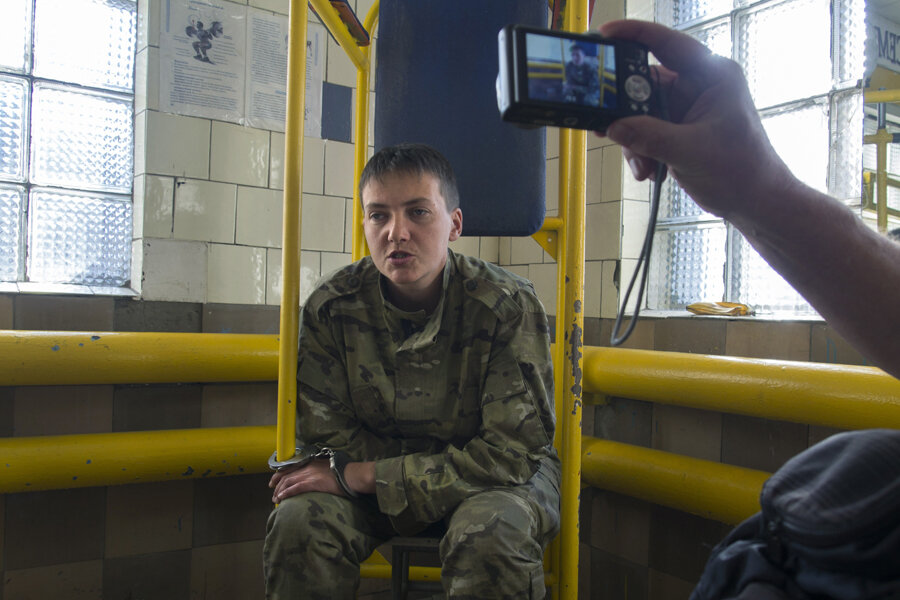How did a female Ukrainian pilot end up in a Russian prison?
Loading...
A few weeks ago, Nadiia Savchenko was just another Ukrainian volunteer fighting separatists in Ukraine's east. Today, she sits in a Russian jail, charged with playing a part in the deaths of two Russian journalists.
Just how the Ukrainian Air Force helicopter pilot, nicknamed Ukraine's G.I. Jane, went from partisan to prisoner remains murky. But her captivity is a growing point of contention between the Ukrainian and Russian governments – and has even spawned a "#saveourgirl" hashtag campaign within Ukraine.
One of the few facts that both Kiev and Moscow agree on is that Ms. Savchenko is being held in Russia, reportedly in a detention center in Voronezh, a Russian city a few hundred miles from the Ukrainian border.
A spokesman for Russia’s Investigation Committee told Russian news agency ITAR-Tass that Savchenko crossed into Russia disguised as a refugee and was later detained during a passport check. No reason was given for why she crossed into Russia without any sort of identification.
She was arrested on July 2 in connection with the murders of Igor Kornelyuk and Anton Voloshin, both of whom worked for Russian state broadcaster VGTRK. The two journalists were killed in the eastern Ukrainian city of Luhansk on June 17 and have been portrayed in Russia as heroes. They were posthumously awarded the Order of Courage by Russian President Vladimir Putin.
But the Ukrainian government says that Savchenko was kidnapped by eastern rebels and taken across the border into Russia in violation of international law. The Ukrainian foreign ministry condemned her captivity as "illegal trafficking," and "proof that terrorists are planning and committing their crimes on the territory of Ukraine in close cooperation with the secret services of the Russian Federation.”
Interfax reported that the American embassy in Moscow issued a statement yesterday regarding the situation. "We are aware of the situation with Nadezhda Savchenko's illegal arrest. We condemn her arrest by separatists, her illegal transfer to Russian authorities and the fact that she is still under arrest," said an embassy representative. "We appeal for her immediate release."
BBC’s Ukrainian language service reported that President Petro Poroshenko has discussed the situation with German Chancellor Angela Merkel and French President François Hollande.
#SaveOurGirl
Savchenko's plight has fed into the information war between Kiev and Moscow. In Ukraine, social media users have launched a hashtag campaign of "#saveourgirl," a play off of the famous "#saveourgirls" hashtag that went viral with Boko Haram's kidnapping of female students in Nigeria.
Ukrainian Foreign Minister Pavel Klimkin told journalists yesterday that the Ukrainian government does not trust the lawyer appointed by the Russian government for Savchenko and that they are looking for a new attorney. He later tweeted about it, using the hashtag.
Meanwhile, Russia's media is portraying Savchenko as part of a Kievan campaign against oppressed Russian-speakers in Ukraine's east. In an interview with Russian tabloid Komsomolskaya Pravda published on June 24, Savchenko was asked "Why did you come to [eastern Ukraine] with arms?" She replied, "It is our land."
The interviewer continued, "Let's call it as it is. People [in the east] have the right not to subordinate themselves to the Kiev junta. Do they have the right to live according to their convictions?" Savchenko shot back, "They do not want to subordinate themselves to Kiev but to Moscow."
After discussing politics and war, the interviewer moved on to odder questions, including asking Savchenko why she had never married. "You have been in the Ukrainian army for 10 years and haven't yet found such man?" She replied, "I do not need a man who is ready to die in a battle. I need a man who dares marry me."
Yesterday ITAR-Tass quoted a human rights activist who had visited Savchenko in prison saying, “She has no complaints about the conditions and treatment in jail.”
Who is Savchenko?
Savchenko’s background has become a popular subject in Ukrainian media, with Espreso TV asking in a headline, “Who is this Nadiia Savchenko who the Russians want to imprison for life?” An entire website to save Savchenko was launched by Ukrainian TV channel 1+1.
According to various reports, Savchenko, a Mi-24 helicopter pilot, was on leave from the military when she joined a volunteer battalion fighting separatists in the east, where she was later captured.
She was profiled in 2011 in a Ukrainian military video that described her sometimes difficult career path from design and journalism student to pilot. “She dreamed of the sky from childhood…. She wanted to pilot fighter planes,” the narration says.
According to the film, Savchenko served for six months as a peacekeeper in Iraq before attending a Ukrainian Air Force academy in Kharkiv in 2009. The film features factoids about Savchenko (her favorite movie is Shawshank Redemption) and interviews with her mother and friends and compares her to the title character of Hollywood movie “G.I. Jane.”
Savchenko says that for when you are flying, “you are in paradise.” Towards the end of the video she says, “I think a lucky person is one who dies doing what one loves…. I think I must be one of those people.”








